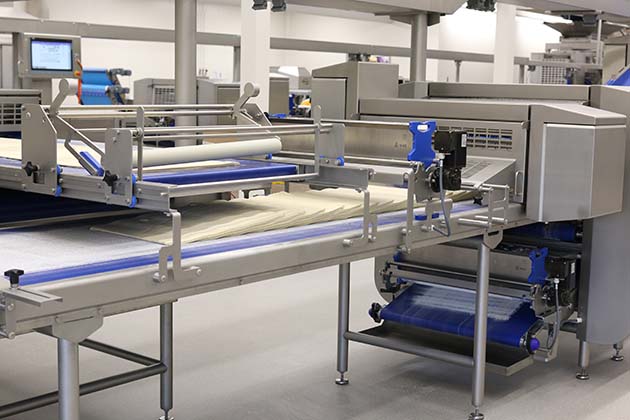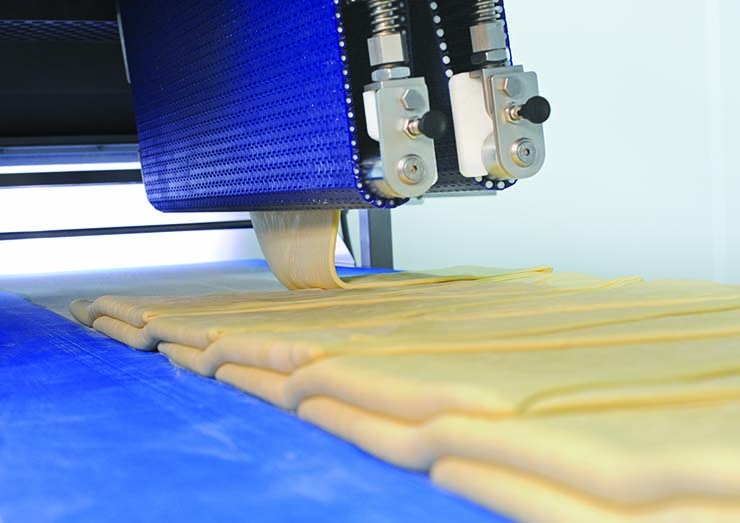
From viennoiserie to Danish pastry, and any number of hybrid, new creations, laminated dough is the path to the sought-after airy, light layers. Gentle dough stretching and folding is a must, however, there is by no means a one-size-fits-all approach to the process. Tried and tested laminating methods and line setups can accommodate flexibility and consistency in results.
Precision and consistency are required to turn blocks of dough into thin, delicate sheets. The big challenge lies in the correct distribution of the dough reduction steps while avoiding any unwanted tension in the dough. Inconsistencies in the reduction steps will significantly impact the structure of the final product. Keeping rework dough under control is another important aspect, according to the reduction plan chosen on the line, Rademaker experts point out.
Three methods with Rademaker
Rademaker developed three different laminating methods, to closely match different types of dough, production capacities and processing needs. “Every dough type and end product require a specific application and laminating method. It is also possible to apply inline laminating, as it knows no restrictions regarding laminating widths of up to 1,600m,” Rademaker explains. The three methods are:
+ Lapping: The dough sheet runs vertically within a guiding system that moves back and forth. This symmetric lamination method is unsuitable for soft dough and has a maximum lamination width of 600mm.
+ Horizontal laminating: The belt with the dough sheet moves back and forth above the next conveying belt. This is an asymmetric lamination system suitable for soft dough with no restrictions regarding the laminating width.
+ Cutting and stacking: A guillotine cuts the dough sheet into rectangular sheets that are then stacked on top of each other. This flexible, symmetric system lays both even and uneven layers. It is suitable for soft doughs, with no restrictions regarding the laminating width.
Rademaker laminators are developed to produce many varieties of laminated dough for mid-sized to industrial bakeries, combining process and recipe information to optimize flour usage and for a fast start-up. It is the end product with its requirements that ultimately dictates the best process and associated solution. To develop customized laminating solutions, Rademaker uses its standardized units in the construction of a complete line: “We build a line and adapt it to the desired situation. In addition, for each recipe, we can define our own parameters needed in the processing of the various doughs and/or fats,” the specialists explain. This flexibility allows for a wide variety of configurations, from a block processor to a fully automated laminator, with working widths varying from 600 – 1,600mm. The laminators can be designed in different shapes (L-shape, U-shape, Z-shape etc.) and laminating belts can also be set up straight in-line. “Thanks to this flexibility, the line can be optimally configured to meet customer-specific applications, resulting in the best possible production efficiency,” Rademaker explains.
To integrate them with existing technology, a signal exchange is possible with the upstream equipment, but is less necessary. This is strongly recommended, however, with the equipment downstream of the laminator. Rademaker stresses: “In case of stops, for whatever reason, in the downstream flow, you will also want to stop production on the Rademaker line. This feature is provided in our production lines.”
“Process control utilizing intensive data handling and communication is becoming increasingly more important in industrial production processes. “
Rademaker specialists
A light touch, automated as needed
Dough-friendly processing is key for light, airy products with laminated dough. Rademaker designed its dedicated equipment, “to focus on efficiently handling the dough with the utmost care, at the required capacity.” Then, depending on how the dough reacts in the starting phases such as the reduction step, the next steps are mapped out for the appropriate production setup. Laminated doughs with margarine, for example, can be processed without cooling and resting; conversely, cooling becomes a necessary step after layering the fat when softening butter. This involves not only temperature control, but also that of the humidity of the ambient air. “An incorrect relative humidity can cause dehydration as well as condensation, which certainly makes it a point of attention,” Rademaker points out.
Its laminators range from semi- up to fully-automatic production lines. Manual processes can include taking laminated dough blocks off the line for cooling or proofing, and placing them back onto the line, for example. “For a fully automatic process, we have transferred the cooling and resting traditions into an industrial process solution. In this way, we can offer a fully-automated laminator with capacities of up to 10,000kg of dough per hour,” adds the specialist.
The cooling and resting system can be optionally added, especially for the continuous processing of laminated and sheeted dough. Cooling ensures that the integrity of the layers remains intact and that the fat and dough layers are consistent, resulting in a significant improvement for further processing of the dough sheet. Resting directly influences taste and shape/volume, the combined result of dough relaxation (stress reduction) and controlled yeast activity. The outcome of this process is the development of mono sugars and CO2. “With our Cooling & Resting system, operating with indirect air coolant for accurate temperature control, we have transferred the artisan traditions of the past into an industrial process,” Rademaker explains. The cooling principle of the system consists of tubes positioned underneath the belt, creating an active air coolant while minimizing unwanted vaporization. Because no air is directly blown onto the dough sheet, the dough will not dehydrate. With this system, a minimum coolant temperature of -17°C can be achieved.
Automation features are incorporated to make the Rademaker laminating line adjust to parameter changes it detects: when deviations are measured, either in the dough or in the process, the line course-corrects the process flow using its automatic speed adaptation (Cascade control). The specialists elaborate: “The advanced control system features fully automatic speed adjustment and enables the different sections to operate independently.” While the last dough part of the production run is processed towards the last section of the line, the first section of the line is ready for cleaning or to start the production of another product. The operator receives a notification when the next recipe can be started on the machine.
In addition, smart features are built in to closely control the operation. “Process control utilizing intensive data handling and communication is becoming increasingly more important in industrial production processes. Our control platform enables OMAC based data exchange with neighboring (third party) equipment as well as LMS, MES, or ERP systems,” Rademaker highlights. Moreover, the equipment can be monitored and optimized online for efficiency, thanks to advanced data processing.

The article is part of an extended feature, which was originally published in [BBI 1 – 2022]. Read the full article in the magazine:


